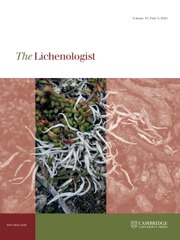No CrossRef data available.
Article contents
Phylloblastia iranica sp. nov. and a new record for the lichen biota of Iran, with a global key for Phylloblastia species
Published online by Cambridge University Press: 31 December 2024
Abstract
Phylloblastia iranica S. Kazemi, Lücking & Sipman sp. nov. is described and illustrated as a new foliicolous lichen. It is characterized by 1-septate, colourless, more or less fusiform, slightly curved ascospores, 9–19 × 4–6 μm. In addition, the foliicolous Strigula buxi Chodat is reported for the first time from Iran, increasing the number of foliicolous lichens known from that country to three, where previously only Gyalectidium caucasicum (Elenk. & Woron.) Vězda was recorded. All three species were found in boxwood (Buxus sempervirens) forest. A key to all known Phylloblastia species worldwide is provided.
Keywords
- Type
- Standard Paper
- Information
- Copyright
- Copyright © The Author(s), 2024. Published by Cambridge University Press on behalf of The British Lichen Society



